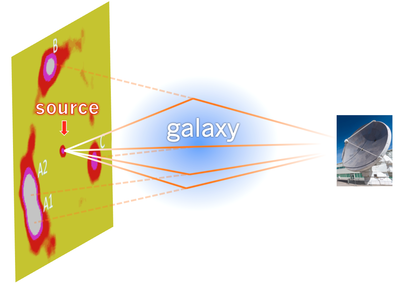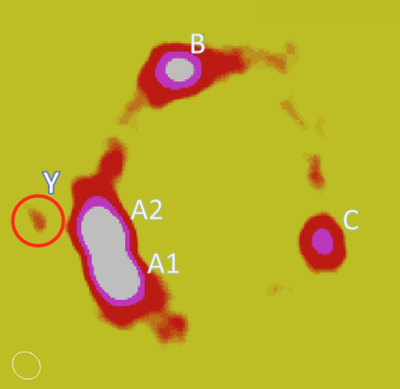Dark Dwarf Galaxy Spotted by ALMA
2017.02.10
Kaiki Taro Inoue, at Faculty of Science and Technology, Kindai and Takeo Minezaki, at School of Science, University of Tokyo, with their collaborators, discovered a faint signal, which is considered to be an emission from cold dust in a dark dwarf galaxy (very small dark galaxy) using the world's largest millimeter/submillimeter interferometer at Chile, called the Atacama Large Millimeter/Submillimeter Array (ALMA). Their discovery will be a first step toward understanding the origin of mysterious dark dwarf galaxies in the universe. The result was published in "The Astrophysical Journal Letters", an international academic journal of astrophysics on Jan. 30, 2017.
【Summary】
● The team detected a signal which is consistent with an emission from cold dust in a dark dwarf galaxy.
● The team used ALMA, the world's largest millimeter/submillimeter interferometer.
● First step for understanding the origin of dark dwarf galaxies.
【Abstract】
The so-called "missing satellite problem"is one of the most challenging problem
in the modern astrophysics: Theory predicts an excess number of dark subhalos around the Milky Way than observed satellite galaxies, which are expected to trace them.
If theory is correct, we expect a number of dark dwarf galaxies in the universe. Since dark dwarf galaxies are faint, the methods for detecting the objects are limited: either detection of a faint signal or the"gravitational lensing effect", bending of light rays passing by a massive object.
A research group led by Kaiki Taro Inoue at Kindai and Takeo Minezaki at University of Tokyo observed an object at 11.4 billion light years away from us using ALMA. They found a mysterious signal in the vicinity of the object, which is considered to be an emission from cold dust (tiny rocks and ices) at about 5 to 8 billion light years away. They concluded that if the emission comes from a dusty dark dwarf galaxy, then some other anomalous phenomena can be explained simultaneously (refer to the following for detail).
【Reference】
■Journal name:'The Astrophysical Journal Letters'
International academic journal of astrophysics, published by IOP for American Astronomical Society (Impact Factor:5.487, 2015)
■Title:'Evidence for a Dusty Dark Dwarf Galaxy in the Quadruple Lens MG 0414+0534'
■Author:Kaiki Taro Inoue, Satoki Matsushita, Takeo Minezaki and Masashi Chiba
【Result】
A research group led by Kaiki Taro Inoue, at Faculty of Science and Engineering, KINDAI, and Takeo Minezaki at University of Tokyo observed an astronomical object 11.4 billion light years away, called 'MG0414+0534', which is a quadruply lensed quasar (Fig.1). In order to explain the ratios in the flux of lensed images, researchers postulated a dark dwarf galaxy as a lensing substructure.
In their observation, a faint radio signal (at wavelength of 0.9 mm) was detected in the vicinity of a lensed image A2 denoted as'Y'(Fig.2). The signal is considered to be an emission from cold dust (small rocks and ices). If a dark dwarf galaxy resides at the place of'Y', anomalous flux ratios observed in mid-infrared and submillimeter bands and dust reddening observed in optical and near-infrared bands are explained simultaneously. Thus, they concluded that the signal comes from cold dust in a dark dwarf galaxy at a cosmological distance.
【Jargon】
・ALMA ......ALMA is an astronomical interferometer of radio telescopes in the Atacama desert of northern Chile. It consists of 54 antennas with a diameter of 12m and 12 antennas with a diameter of 7m.
・dark dwarf galaxy... a very faint galaxy with a mass of less than a billion solar mass.
・subhalo... a small dark matter halo that is belonging to a larger host dark matter halo.
・quasar... a very bright astronomical object in the distant place. The emission comes from fast accreting gas surrounding a super massive black hole.


